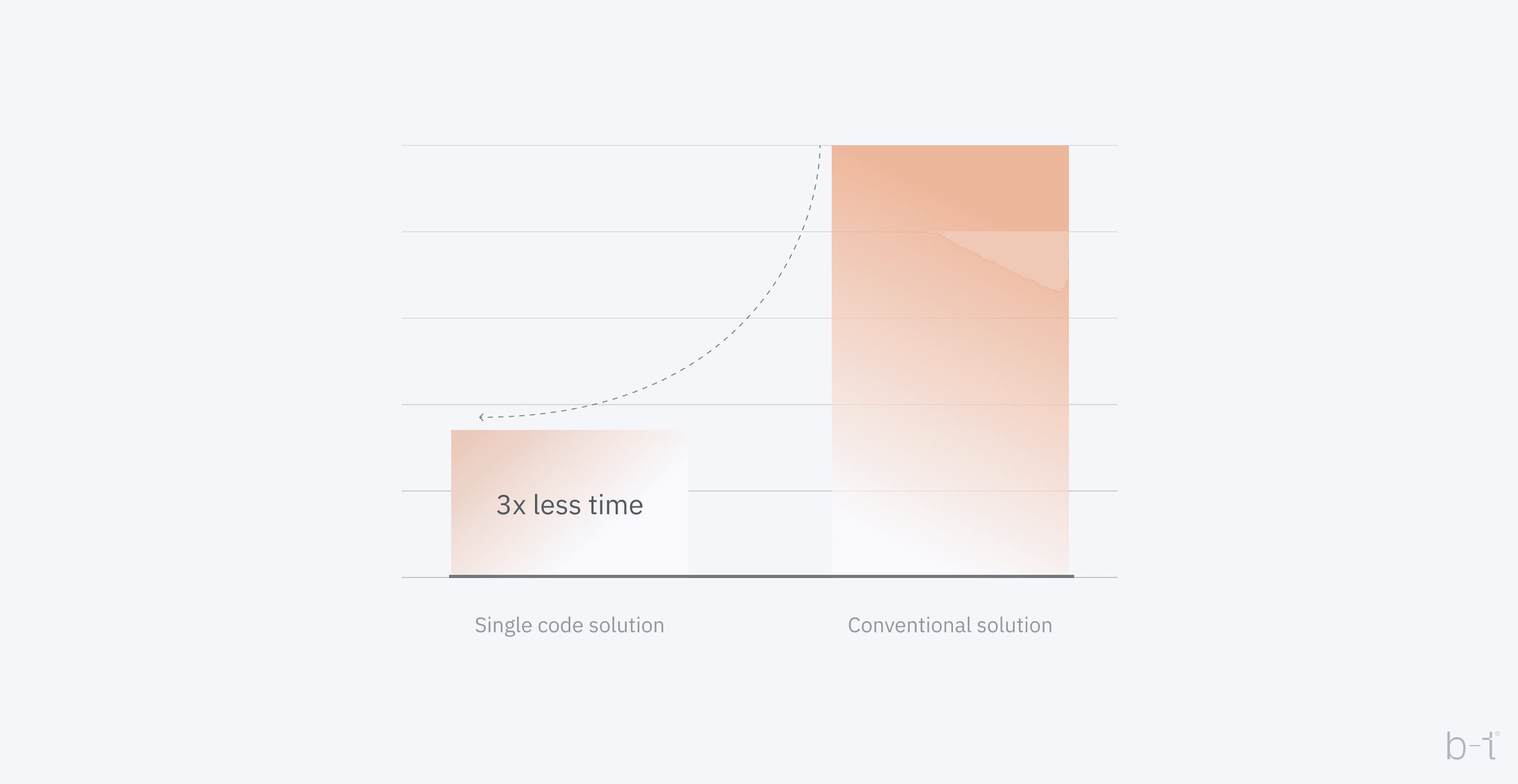Introduction
Bloomteq achieved positive outcomes by implementing strategies to streamline candidate sequencing and contact enrichment, resulting in a more efficient and personalized recruitment pipeline.
Additionally, we bolstered data security by effectively handling data ownership through a common identity service, consolidating data management, and facilitating quicker iterations across global systems.
Furthermore, distributing a one-codebase application across multiple regions enabled us to serve diverse markets seamlessly while reducing development time and resources.
About
Bloomteq has extensive experience collaborating with various firms operating within the human resources sphere. We have provided our services to multiple enterprise companies, delivering tailored solutions to address their specific challenges and objectives.
Our expertise extends to developing full-scale solutions encompassing our clients' requirements, ensuring comprehensive and effective outcomes.
Furthermore, our adept management of both internal and external teams has been instrumental in facilitating seamless project execution and delivering exceptional results for our clients.
Background
Bloomteq is a trusted enterprise software and product development company that navigates the digital landscape, evolving at an unprecedented pace and standing as a beacon of unwavering dedication to our clients. Reflecting on our journey, we take pride in our evolution into a symbol of quality and reliability within the industry. Our commitment to fostering a dynamic and inspiring workplace culture has been instrumental in driving our success, attracting top talent, and fueling our passion for technological advancement.
By combining our wealth of experience and diverse skill sets among the team of 100+ experts, we have unlocked a new realm of possibilities to exceed client expectations. This synergy empowers us to deliver superior solutions with increased efficiency and effectiveness, setting a new standard for excellence in the field. Our steadfast dedication to delivering exceptional work remains at the core of our ethos, and through Bloomteq, we are poised to realize our ambitious goals and solidify our position as a premier destination for software development.
We believe in forging relationships that withstand the test of time, grounded in a commitment to sustainability and a passion for delivering software solutions that redefine industry standards. Looking ahead, Bloomteq's strategic vision encompasses not only meeting client needs but also driving innovation, generating employment opportunities, and championing educational initiatives.
Challenges
Ahead is an overview of individual challenges, together with brief explanations about the problem statement, solution, implementation and outcome.
Challenge 1 ⎯ Streamlining Candidate Sequencing and Contact Enrichment
Problem statement
Effectively engaging with candidates through diverse communication channels presents a significant challenge in the recruitment industry. Coordinating sequences through various channels while ensuring a personalized and efficient outreach strategy was a challenging and time-consuming process.
Furthermore, the demanding task of enriching candidate profiles with extensive data and tapping into a global talent pool placed a significant burden on recruiters, requiring them to gather information from multiple sources.
Solution
We have introduced a sophisticated sequence management system, seamlessly integrating email, phone, SMS, and LinkedIn channels, allowing recruiters to design, schedule, and track candidate interactions all in one place.
The platform further improved the recruitment process by incorporating enrichment service providers, enabling recruiters to effortlessly gather comprehensive candidate information from LinkedIn URLs or email addresses.
In addition, we have implemented the World Talent Pool, aggregating millions of global candidates with advanced search options, empowering recruiters to enhance their candidate sourcing capabilities and seamlessly add top talent to their sequences.
Implementation & Outcome
Implementation
Multiple user-friendly methods were implemented to facilitate seamless candidate consolidation and create a centralized dashboard. Among these, a Chrome extension was developed, simplifying data extraction from candidates' LinkedIn profiles for easy integration into the system. Additionally, recruiters can efficiently submit batches of candidates by uploading a CSV file containing essential candidate information. We've incorporated the People Data Labs Pearson search API and Elasticsearch queries to simplify candidate engagement challenges in recruitment. This integration allows for a comprehensive worldwide search of candidates. To enhance the search process, we've implemented various filters and Boolean search parameters, streamlining the identification of top talent.
A unified set of candidates enabled us to provide recruiters with a seamlessly integrated system to design, schedule, and track candidate interactions across email, phone, SMS, and LinkedIn channels. Leveraging advanced automation, the platform implemented triggers responsive to candidate actions or inaction, ensuring the precision and timeliness of follow-up communications throughout the recruitment process. This sophisticated system goes beyond traditional features, offering a WYSIWYG editor for creating custom emails enabling recruiters to design visually compelling and personalized communication.
Recruiters can also create dynamic sequences of messages that automatically trigger when a candidate responds, enhancing communication efficiency. Additionally, the system allows recruiters to set specific schedules for message sequences, offering flexibility by enabling the selection of workdays for optimal engagement. This functionality not only elevates the technical capabilities of the recruitment process but also provides recruiters with a tailored and efficient approach to candidate communication.
In addressing the complexity of candidate engagement in recruitment, our integration with enrichment providers such as People Data Labs and Rocket Reach plays an important role. Leveraging these platforms, we gain access to vast candidate information, encompassing details like employment and education history, place of residence, mobile phone numbers, and an array of business and private emails or social media links.
This robust feature significantly streamlines the recruitment process by eliminating the need for manual searches empowering recruiters with comprehensive insights into candidates they are reaching out to. Combined with the People Data Labs Pearson search API and Elasticsearch queries, this approach not only simplifies communication but also ensures a data-driven, efficient, and informed recruitment strategy.
Outcome
The final product resulted in a streamlined, efficient, and personalized candidate engagement process for recruiters. With the ability to create and manage sequences seamlessly across multiple communication channels, this platform transformed how recruiters connect with candidates, fostering a more engaging and responsive recruitment
pipeline.
Challenge 2 ⎯ Enhancing Candidate Pipeline Integration with ATS Systems
Problem statement
One of our clients sought to enhance the candidate pipeline experience beyond standard market solutions. The final product aimed to integrate with existing ATS systems seamlessly, manage proprietary operations, and synchronize updated data back to the ATS seamlessly. Each ATS with an exposed supporting API comes with its own complexities, and there is no one-size-fits-all solution.
Solution
We've developed a decision-making tree that triggers different ingress and egress operations by identifying shared characteristics among various ATS systems. This approach enabled the client to efficiently expand the roster of supported ATS systems while maintaining scalability.
Implementation & Outcome
Implementation
We've developed a module within the client's product that allows end users to connect one or multiple ATS systems seamlessly, leveraging the Merge API for efficient integrations. Given the unique connection flows of each ATS, users are provided with simplified tutorials to facilitate the connection process for systems like Lever, Greenhouse, Ashby, and RecruiterFlow.
Following the initial setup, end users are relieved from managing ATS connections. We engineered an ingress system to retrieve jobs and candidates from each ATS, deduplicate data, and seamlessly present it within the product dashboard. Users then engage in proprietary platform operations, with all entity updates automatically synchronized back to the ATS systems.
This robust implementation ensures an efficient candidate pipeline integration experience, with the ability to easily incorporate additional integrations as needed. The synchronization of data back from ATS is orchestrated through webhooks, ensuring real-time updates. Every change within our system, encompassing candidates, applications, notes, and files, is automatically synced back to the respective ATS systems, maintaining data consistency and enhancing the overall technical efficacy of the integration process.
Outcome
Integrating a decision-making tree and a user-friendly module empowered our client to connect seamlessly with diverse ATS systems, enhancing the candidate pipeline experience. This implementation not only relieved users from ATS complexities but also facilitated rapid integration with new ATS based on customer desires, providing added value from the customer's perspective.
Challenge 3 ⎯ Handling data ownership
Problem statement
Managing an international system encompassing numerous entities across various databases posed the challenge of securely establishing data ownership to prevent unauthorized access and potential data breaches.
Solution
The solution we implemented with the client was a shared identity service, where the ownership of a single identity could be passed down to the end user. In the end, the end user would have complete control over what PII, or any other relevant data, is exposed to different system principals, as well as to potential employers.
Given the operation's scale and the nature of jobs offered on the platform, most opportunities needed a particular profile of people. Therefore, the end user's personal data was not required until the user was invited to partake in a certain job opportunity.
An added benefit was the ability to consolidate particular identities across multiple geographical regions, providing a natural way of deduplicating identity entries. The central concept during the design and implementation of the system was a "single source of truth", ensuring that in the final product, all the integrated internal systems would relinquish data ownership and rely on the identity service to provide the necessary data for their day-to-day operations.
Implementation & Outcome
Implementation
The implementation of the typical identity service is split into four modules:
- Building the secure API to store and provide regulated access to PII data.
- Creating event-driven patterns that enable data fortification and the ability to track data changes in a time series.
- Building out authentication patterns for system principals and a foundational setup for the end user data ownership.
- Assisting different teams with a smooth transition to the new data governance standard
The main challenge in the development of this solution was consolidating permissions. Since multiple systems could have produced the data, combined with the PII data the user entered through different channels, permission levels needed to be split into various layers.
The permission layers are scaled both horizontally and vertically. The horizontal scaling enabled managing different principals on the same permission levels. Depending on security clearance levels, "lower" principals add more access based on their permissions. The final layer was the end-user layer. The end users were also considered system principals, with the main difference being that their authentication pattern didn't use a pair of RS56 keys but a biometric fingerprint from their mobile phone. Lower layers had more control over data governance, so if they locked down a particular piece of data, the higher layers would not have access to it. Once any principal queries a certain entity, all permission layers are "collapsed" into one, and the defined guards allow only the exact data the principal system can access.
An extra layer of complexity was added because the systems were in production for a very long time and the transition to a new pattern of data ownership needed to happen without any outages in system availability.
Outcome
A key advantage of the implementation is consolidating data ownership into a single managed location. Once the system is operational, various integration teams no longer need to concern themselves with data governance rules or permissions, as the identity service guarantees proper parsing of any data transmitted to external systems.
The developed system was protected with multiple layers of security, including, but not limited to:
Ultimately, after the data consolidation was finalized and the updated data governance approach implemented, the platform experienced heightened data security. This, in turn, facilitated quicker iterations across various global systems, as the implementation teams were no longer burdened with the need to comprehend data governance intricacies.
Challenge 4: Distributing a one-codebase application across multiple regions
Problem statement
Overseeing the legal, cultural, and functional specifications for end-user applications across various continents typically involves creating and maintaining distinct applications tailored to each region. Such an approach necessitates significant investments of both time and resources.
Solution
In collaboration with our clients, we've crafted a unified codebase for a global application that can be customized to suit any geographic location.
The solution we've deployed is a cross-platform, native mobile application, along with its backend, capable of seamless deployment to both Google Play Store and Apple App Store via automated pipelines. Each delivered application is tailored with specific configurations based on the respective "tenant" for which it was created.
Implementation & Outcome
Implementation
Employing a TypeScript-based tech stack, we've developed a cross-platform mobile application with a unified codebase. This application operates as a collection of modular components, where the supporting API system suggests directives to the end-user on enabling features and configuring them accordingly.
This configuration led to the creation of an internally labeled "global" system. Following the initial release of the app in the US market, various tenants were incorporated, and their unique features, functionalities, and integrations were seamlessly integrated as modular components into the global application. After our involvement, the app served nine different countries with a single unified platform.
Each application boasted a visually distinct user interface. At times, this distinction was merely reflected in alterations to the color scheme and incorporation of company branding. In more intricate scenarios, entirely new components were developed to accommodate the requisite functionalities mandated by each respective country's legal regulations (or functional requirements).
Through meticulously designed backend API schemas and a sophisticated permission system, we diligently safeguarded against inadvertent horizontal data leakage while maintaining millions of user entries and their associated metadata within a centralized repository. This centralization of data substantially streamlined integrations with various ATS or CMS systems, including Bullhorn, Lever, Ashby, and Sitecore.
Outcome
Upon the release of the initial product version, our client effectively expanded a singular development team and accelerated iterations for market releases in various regions, in some cases achieving a pace 2-3 times faster than traditional development approaches.
 Figure 1: Time to market
Figure 1: Time to market



 Figure 1: Time to market
Figure 1: Time to market





